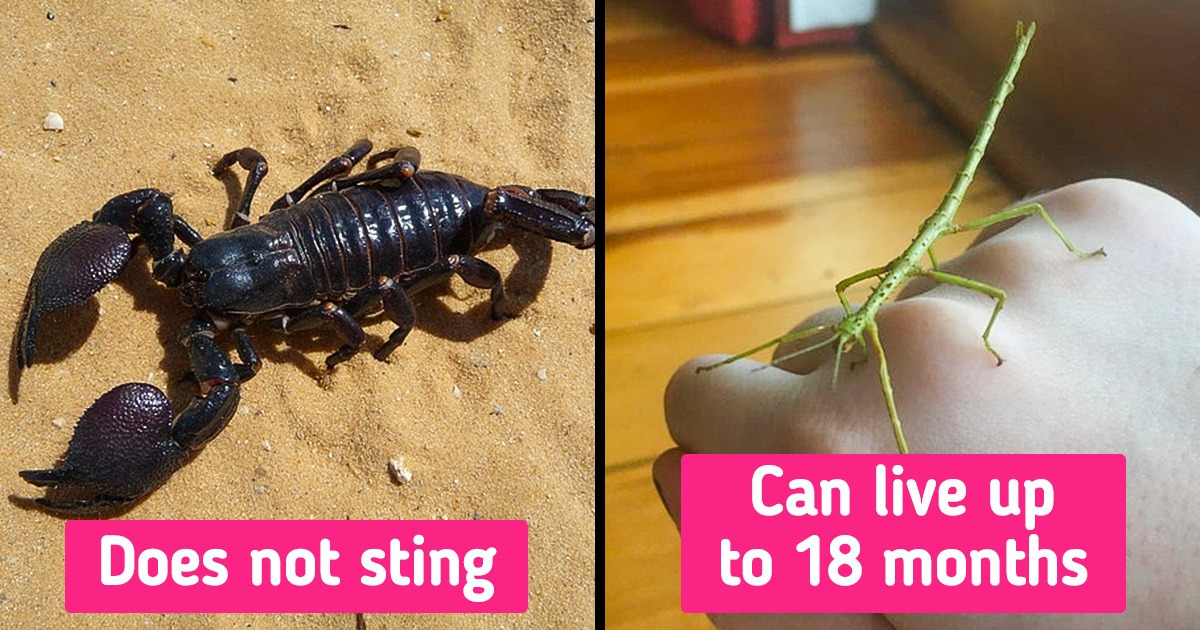I Refused to Take My Ex Back, and My MIL Made Sure I’d Regret It


Daring creatures, such as non-poisonous snakes or scorpions, have quickly become pets for those wanting a more unique companion. They are often harmless and even low-maintenance. Such species are not only fascinating to look at, but they also break the rules when it comes to ordinary pets.
Here at Bright Side, we enjoy a wow factor, and these pets did not let us down.
The Emperor scorpion is the universally recommended scorpion due to its docile nature. Rather than stinging, it usually just pinches a little. The stinging comes into play when it feels threatened or cornered.
Not only is it easy to find outside, but this small insect is easy to care for, only needing a small tank. Its relatively short lifespan of one year makes it an easy pet for those who are not used to having insects as pets.
They take a variety of prey, like fruit flies, moths, or crickets every once in a while. For water, a small water dish will do.
Rats are a good option when talking about pets. The only thing to keep in mind would be buying rats in pairs. They have to be either 2 males or 2 females.
They are extremely neat, cleaning and organizing their food themselves. All they need is a wire cage with some litter on the floor so it remains clean. Rats are omnivores, so they eat grains, vegetables, and a protein source, such as dry dog food. Provide a water bottle that should always be cleaned.
Leopard geckos thrive in a bigger tank and must be housed individually. Old fish tanks work as well. Their habitat must be cleaned twice a month to ensure a healthy life, otherwise, quick cleaning of the feces is the only concern, once a day. Once a week, soak your gecko in warm water to help with hydration.
Use a white light incandescent heat bulb to provide a basking spot during the day. A red, blue, or purple heat bulb can be used during the night. For food, they appreciate crickets, waxworms, and, in moderation, mealworms. Provide a small water dish for the gecko to drink out of.
Since corn snakes like warm environments, a wooden vivarium is recommended. During the day, these snakes thrive in basking light, and during the night, in complete darkness. They appreciate a lot of decoration since they enjoy climbing.
Mice are their primary food source, shifting from smaller mice during their youth to bigger ones as it grows. When small, they should be fed weekly, lowering it down to once every 2 weeks when they’re grown.
Water must be provided in a medium or large water bowl and kept cool at all times.
For these small frogs, the water in the tank must be kept at a temperature between 72ºF and 78ºF (22ºC-25ºC), and its pH levels between 6.5 and 7.8. Since they are nocturnal, they require a fixed day and night cycle, so 10 to 12 hours of aquarium lighting daily is recommended. To achieve this, a basic LED hood light will do the job.
Decorate the tank with caves and logs since these little creatures like hiding a lot.
Tweezers are handy when feeding them since they must be fed in small portions. They take in freeze-dried bloodworms, frozen brine shrimp, daphnia, and live blackworms.
A plastic or glass aquarium is recommended for a Mexican red knee tarantula. Make sure the top lid has enough ventilation. The temperature of the aquarium must be kept between 75ºF and 80ºF (23ºC to 26°C). The bedding of the tank is important as well, consisting of a combination of peat moss, soil, and vermiculite, at least 4 inches thick (10 cm).
Their food includes crickets, which is the base food for these tarantulas. They also enjoy roaches, locusts, and other insects. Though the amount of food varies based on the age and size of the tarantula, they’re usually fed once or twice a week. Water can be served on a shallow plate.
Its venom is rarely a problem for humans since it only greatly affects small prey.
These little guys can live up to 18 months, and they’re very low-maintenance. All they need is a well-lit plastic tank with a ventilated lid.
Stick insects prefer eucalyptus leaves, provided every 2-3 days. This is also how they get their water, from the leaves they eat.
Humidity is an important factor, so make sure the enclosure is sprayed with a light mist of water once a day.
Grasshoppers are fairly low-maintenance. All they need is an old fish tank, big enough for them to jump in. It must also be covered since they might escape. In general, they do not require heat, however, some species do require a source of heat, just like reptiles. Add some potting for them to stand on.
Their diet consists of hand-cut grass clippings, fresh fruit, and vegetables. In terms of maintenance, just change their water daily and clean the tank twice a month. Add a few sticks and twigs for them to climb on.
All these snails need is a terrarium lined with paper towels at the bottom. There can be multiple snails in one terrarium. Decorate the terrarium with a few leaves since they enjoy hiding under them or even nibbling on them.
Besides leaves, they enjoy vegetables and fruit, such as apples, carrots, and cucumbers. They come out of their shells in moist environments, so spraying the terrarium with some water every few days is a good idea.
Would you get any of the unique pets mentioned? Do you have a daring pet of your own?











